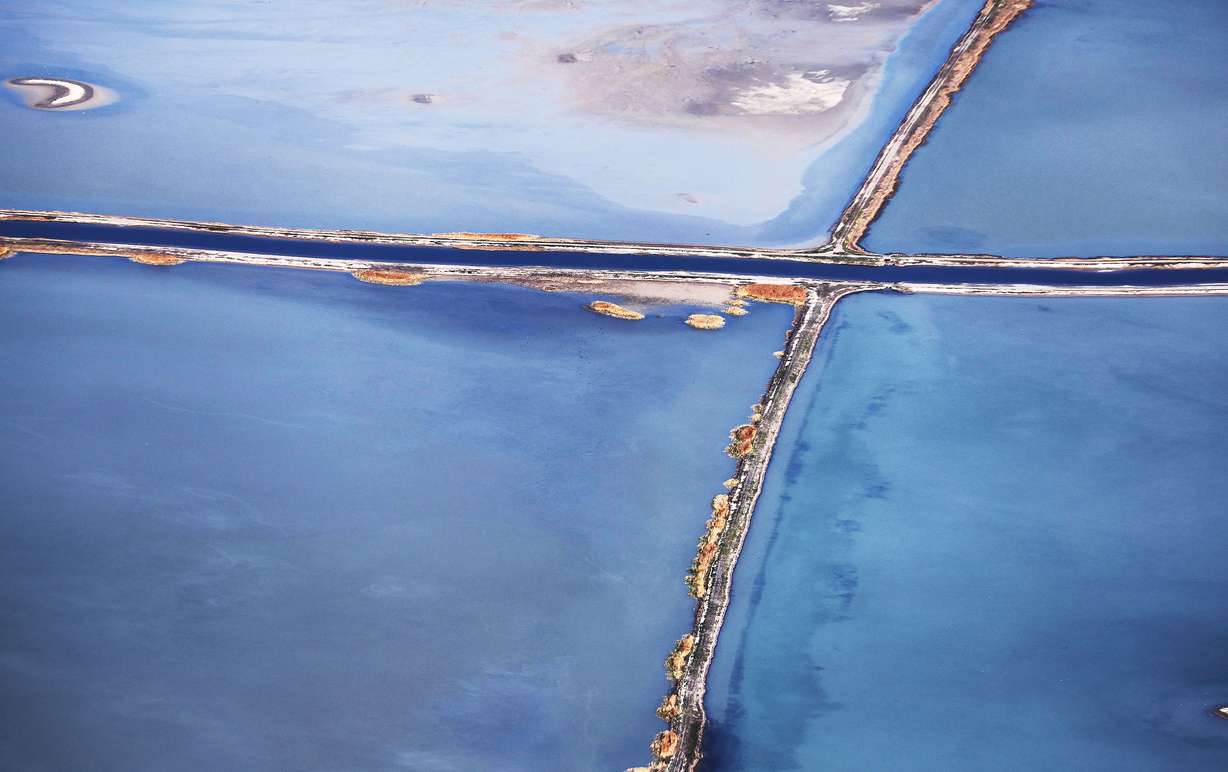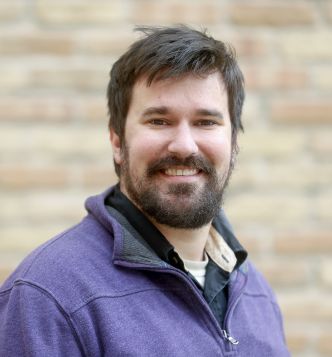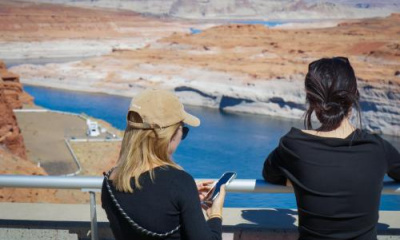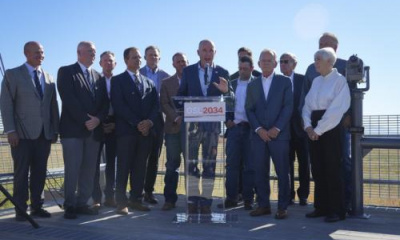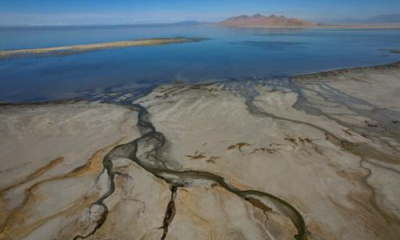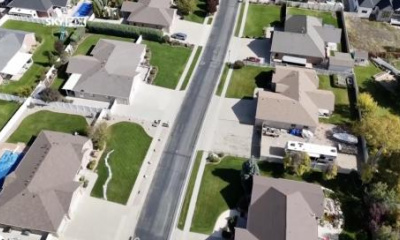SALT LAKE CITY — The future of the Great Salt Lake, and Utah's water security as a whole, is an issue that will require help from everyone living in the state.
That's the message Utah House Speaker Brad Wilson, R-Kaysville, delivered as a keynote speaker Wednesday at the inaugural Wilkes Climate Summit hosted by the University of Utah's Wilkes Center for Climate Science and Policy.
"I think we have learned that this is a statewide task, this is something that's going to require everyone from every corner of the state, with different disciplines and different interests, to all work in conjunction with each other," he said, speaking to a room full of climate experts, government employees and community groups.
While that is a big task, Wilson believes there's enough interest from Utahns of different backgrounds — from politics to where people live — to help reform how the state uses water.
"This has been one of those issues that have brought people together," he added. "It's been really amazing and fun and rewarding to watch people link arms and commit to doing something that is the right thing to do — and we have made great progress."
Bill Anderegg, director of the Wilkes Center for Climate Science and Policy, explained that the two-day summit was created to help identify emerging climate issues. The summit brought in experts to speak on various climate concerns and possible solutions to those problems.
Over 75 international experts also ended up submitting solution projects with the hope of winning the $1.5 million Wilkes Center Climate Prize. More than a dozen more students also submitted projects for the $40,000 Wilkes Center Student Innovation Prize.
While topics included air quality, wildfires and ecosystems, water became a major reoccurring theme of the first-ever summit. It seemed to mirror exactly the type of collaboration that Wilson said needs to happen in order to solve serious water issues.
"It's crucial to have everyone at the table, to approach that and really listen (to) dialogue and bring all of our perspectives, ideas, creativity and solutions to the table," Anderegg said. "Water is an enormous challenge for Utah and really, like with the climate, we're going to need everyone doing their part and bringing their ideas to the table."
Utah's improved water situation
This year's summit occurred as Utah's water situation has improved — at least for 2023. Although the U.S. Drought Monitor lists almost 20% of the state in moderate drought, and another 43% as "abnormally dry," Utah is no longer listed in severe drought for the first time since 2019.
Meanwhile, the state's reservoir system is now about 67% full, close to the average for this point in the water year, now that more than half of Utah's record snowpack has melted, according to the Utah Division of Water Resources.
Joel Ferry, director of the Utah Department of Natural Resources, told a legislative water development commission Tuesday that most of the state's reservoirs are projected to near or exceed capacity by the end of the snowmelt process. There are some exceptions to that, such as Lake Powell.
The Great Salt Lake is also benefiting from the snowmelt, as it is now up to 4,193.1 feet elevation at the Saltair Boat Harbor site, nearly 5 feet higher than it was in November. The salinity levels of the lake's southern arm have also dropped from about 19% to 14% over the past few months, helping the arm avoid serious ecosystem concerns that emerged as it reached record-low levels last year.
This has also helped cover some of the lakebeds that had brought toxic dust into communities during strong storms last year, another major concern with the drying lake, Wilson said. But he cautioned Wednesday that this winter did not provide a long-term fix to the lake's problems or Utah's water situation.
"This water has been a remarkable blessing, but it doesn't mean that we're out of the woods yet," he said. "One good water year ... is not going to reverse the trend of decades of a severe drought in this area."
Sticking with water conservation
Wilson said he's concerned that this winter's deep snowpack caused some people to lose focus of the effort to reduce water consumption in the state, which could make it difficult for people to conserve water this summer. He explained that "meaningful systematic changes" to how Utah thinks about water are still needed to avoid potential pitfalls tied to both the Great Salt Lake and the entire reservoir system.
For example, he estimates that, at the "very, very low end," it would cost Utah $30-40 billion to mitigate the environmental damage caused by an exposed dry lakebed, based on the cost of mitigation at the much smaller Owens Lake in California. It would take about six years' worth of the state's current tax revenue just to cover the cost of repairs, and that doesn't even include indirect costs like health care or impacts on the state's quality of life.
"We know, also, that the Great Salt Lake is really a symbol of a broader issue related to how the state of Utah thinks about our water," he said. "If we don't have a better strategy to manage our water, water will be the limiting factor in our ability to have our loved ones be able to live here in our state, and for our state to be able to continue to grow."
The Utah Legislature passed a handful of new water bills during this year's legislative session that aim to make additional water adjustments. Indirect benefits from some of the bills include more public-private partnerships to promote and educate Utahns about water conservation, a new standard for water districts to calculate and report per consumptive use, and a law that bans homeowners associations from requiring units to have more than 50% vegetative coverage.
The Legislature also provided $200 million more to the state's agriculture optimization program, while Gov. Spencer Cox helped roll out a new program earlier this month that help residents cover the cost of replacing turf grass in eligible municipalities.
Wilson said he believes this legislative session was the second year of "what probably needs to be a 10-year march" when it comes to water reform through legislation.
"We've got to get this right for so many different reasons," he said. "We are, I think, very careful stewards of the natural resources in this state, but there's a lot more work to be done."
Anderegg agrees, noting that the Wilkes Center will continue to hold summits as it seeks to drive home the climate issues that still remain in Utah, in the U.S. and across the world. He has "optimism and hope" that more solutions can be found to address these challenges, given all the attention and interest in the subject.
He also agrees that one good year of water shouldn't stop Utahns from conserving water.
"It's a long game and one wet winter buys us a quick breath but it doesn't, unfortunately, get us out of all of this," he said. "We really need to keep looking at the future and making a lot of these changes to tackle these problems."

